Personal
Portfolio
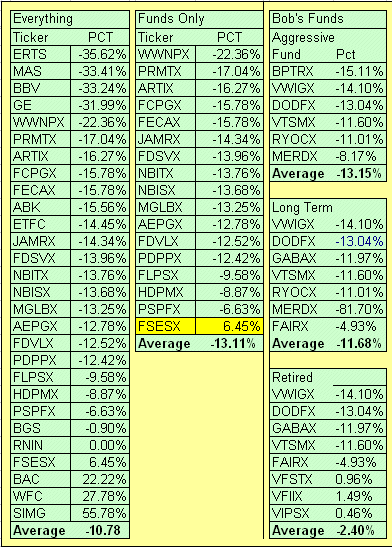
|
The Bank
Stocks
The
general state of the banking industry last month seemed eerily similar
to the after-effects of the dot.com bust in 2000 and it
seemed foolish to ignore financials whose value has been cut in half
if not more, with some being virtually relegated to penny stock status.
I decided to buy WM in the low 3's and some more ABK on speculation,
and increased positions in WFC and BAC.

That run up in
the stock price of WFC provided a boost to the market as a whole. It
was good to see a bank actually increasing their dividend payout. I
think everyone breathed a sigh of relief. That, followed up
by
BAC not cutting their dividend produced some very healthy returns
indeed.
I set BAC and WFC stocks to
reinvest their dividends so with any luck and in a couple years I will
have to start selling shares to keep within the 4-5% of the portfolio
range.
ABK......I
have been trading in and out of this one. I think if you want
to
do some swing trading, this one is worth consideration.
I am keeping a core position in this and basically trading on a
percentage of the profits. It is a gamble.
I
financed the new bank stocks with more Silicon Imaging (SIMG), reducing
it to about 1.5% of the portfolio. I think SIMG still stands
to
do well over the long term but I think more bang for the buck is in
some of the financials.
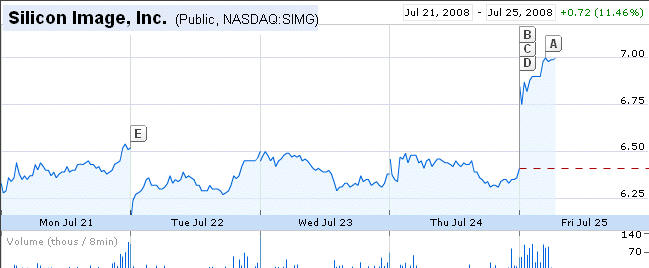
Speaking of doing well long term, investors were pleased with
SIMG's second quarter results. That PE of about 40 is cause
for
consideration though. - a considerable amount of future earnings being
priced
into the current stock price.
Maybe someone knows something we don't and another
'stimulus' check is on the way for buying more HDTV's!
Washington Mutual - I chickened out and sold it prior to their earnings
announcement.

Any other distressed financial institutions out there? Silly
question.
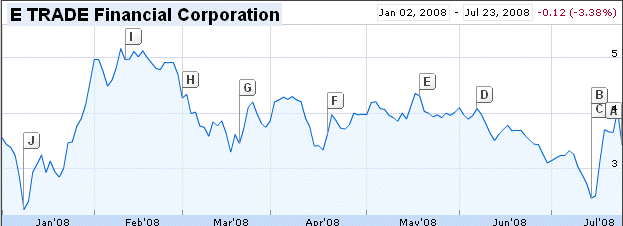
How
about E Trade? They took a big earnings hit but have been
actually growing their subscriber base. I bought this at
$3.53
with
the proceeds from WM. My view is that this one will
recover over time and the price is certainly right. I don't
think
they are going anywhere soon, except as maybe a takeover candidate by
someone like Schwab or Ameritrade.
This month's question of the
month actually comes from my wife:
So
what do you do when your 403B plan
choices have been reduced to pure trash?
A Little
Background
For
years my wife had a 403B plan through Fidelity with the school
district.
It was one of the best plans I had personally
ever seen in terms of fund choices and cost. I
have never had a
retirement plan that good. She made a lot of money in that
account by investing wisely.
Then came the
IRS.
The
IRS in its wisdom decided to change the rules and to make a long story
short, make the district 403B providers more accountable for the
choices of plans they offer. Since the district didn't
........
(I
suppose I should add before proceeding further that the words which
follow are personal opinion.)
want
to be responsible for oversight any more than they had to,
they
sent a questionnaire out to their existing 403B providers and asked
them to respond within a specified time frame. Guess who the
only
responders were? Insurance companies providing annuity plans
and
one brokerage offering loaded funds. (A
More Detailed Explanation is Here)
We went down to the
district's CFO and had a conversation with her about the new plan
choices. Her answer boiled down to one that said the district
was
not obligated to provide a 403B plan at all, so we should be happy we
are being offered one even though it is now a pile of crap.
I
have a legal question: If
a district decides to offer a 403B plan that is a pile of crap and plan
participants get sucked into annuities and other options virtually
guaranteed to lose them money and they do, does the district by
offering up a pile of crap assume a measure of responsibility for
losses
and sub par performance sustained by their plan participants?
A CFO ought to know better than to serve up a 403B plan with high cost
insurance products and loaded mutual funds. I wonder if a
some legal pressure can be brought to bear on the situation.
Examining
the Options
The first thing we
should do is examine the new plan choices before
making further disparaging remarks. Let's get started.
Option 1 - AIG VALIC

You've
got to love Google, aye? AIG pops right up.

It appears the only thing a teacher can get through AIG in terms of
a 403B plan is an annuity.
Let's see what else we can dig up.

Note: Check out the
teachersadvocate sites. There is useful information there.
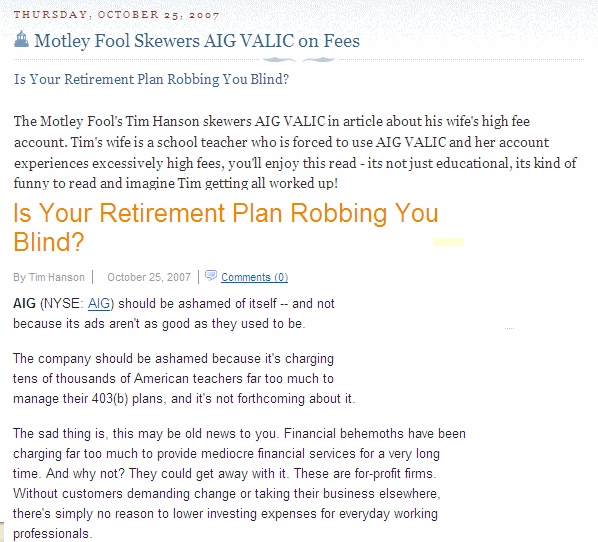
This
is but one example regarding AIG-Valic. I don't think we need
to look any further into AIG as a viable choice for a 403B plan.
Option 2 - American Fidelity

American
Fidelity pops right up too and at the outset identifies itself as an
insurance company.
Want to bet this is another high cost annuity
provider?
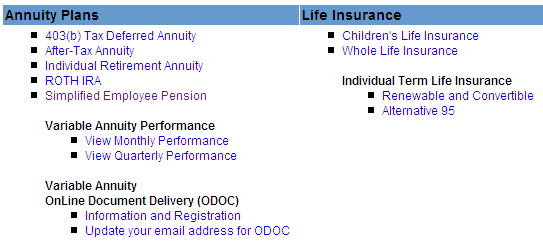
Click
on through and what are the options? Annuity plans.
If you
will notice four choices down, this company has the gall to offer a
ROTH IRA as an annuity. What is wrong with that picture?

I
decided to dig just a bit further since they offered their 2008 first
quarter performance and took them up on their offer to have a look:
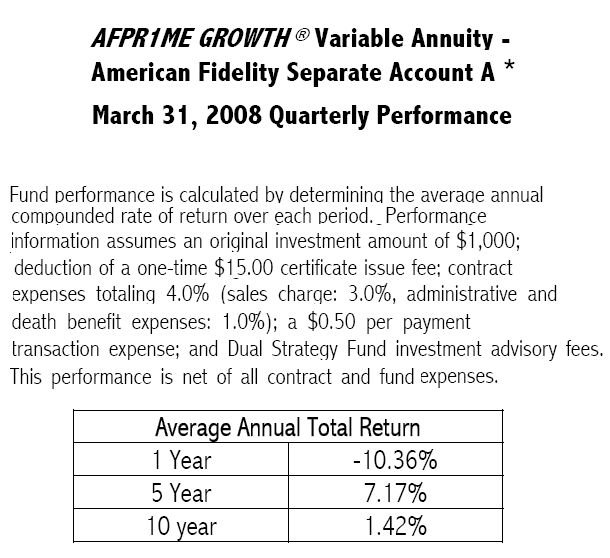
Are
these the performance figures and fees a CFO would be
proud of? Is this something you would offer your friends and
family as an ideal investing vehicle? One thing you will have
to
credit American Fidelity with is that at least they are up front about
the fees incurred in this high cost variable annuity masquerading as a
worthy 403B investment plan.
But hey, if you don't believe me, here is the Original
PDF.
And if you don't like this one, how about their Separate
Account B?
Personally,
I think we will pass on this as a 403B retirement choice.
Teachers don't make enough as it is to have to contend with
the likes of this.
That's two down. Let's check out the third option.
Option 3 - Life Insurance Company
of the Southwest.

I
think it is pretty well established that this is a life insurance
company but look at this! They offer Flexible
Premium
Annuities!

They
even have a happy face more than willing to direct you to your new high
cost variable annuity program! Lets have a look!
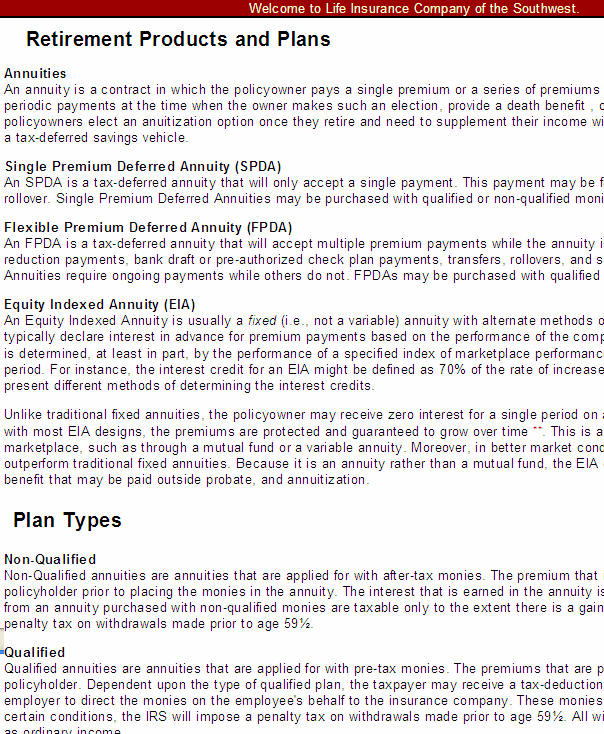
Hmmm............looks
like annuities are the only things they offer to school
district members. Why am I not surprised?

I
could not find much more in this site but I think I get the general
flavor.
I did find some stats while digging around you might be
interested in. Notice that the average commission received by
an
agent for a high cost index annuity is 8%. Look at
the surrender period statement too.
I don't think we are going to go there either.
Moving on to the next choice.
Option 4 - Security Benefit

I think
I am beginning to see a pattern here but in all fairness I suppose I
should click on through.

These people seem to be more into fixed annuities.
Notice the initial bonus of three percent for the one account and two
percent for the second.
Subtract those percentages from the performance shown and
your money would be better stored under the proverbial mattress.

The
NEA choice piqued my curiosity. After all, teachers pay lots
of
union dues to the NEA.
The NEA would undoubtedly have a vested
interest in seeing their members with investment options which would do
the union proud.
At last! An an organization who is looking out for teachers
and their retirement!
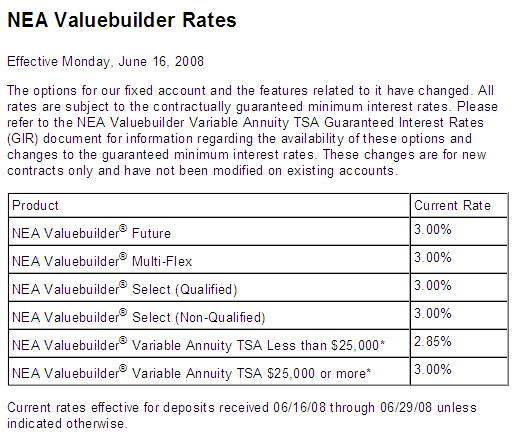
...........or are they.
As a CFO, I wouldn't be overly proud of offering my hard working
district employees this as another retirement vehicle.
As a head of the NEA, I should be embarrassed.
My analysis of this 'investment' choice - Don't Walk.....Run.
Lawsuit
Says Teachers Are Overcharged on Annuities
Article
Tools Sponsored By
By
GRETCHEN MORGENSON
Published:
July 17, 2007
A
lawsuit filed last week in federal court in Washington State contends
that the National Education Association breached its duty to members by
accepting millions of dollars in payments from two financial firms
whose high-cost investments it recommended to members in an
association-sponsored retirement plan.
The
case was filed on behalf of two N.E.A. members who had invested in
annuities sold by Nationwide Life Insurance Company and the Security Benefit Group.
It contends that by actively endorsing these products, which carry high
fees, the N.E.A., through its N.E.A. Member Benefits subsidiary, took on the role of a retirement
plan sponsor, which must put its members’ interests ahead of
its own.
By
taking fees from the two companies whose annuities N.E.A. Member
Benefits recommended to its members, the N.E.A. breached its duty to
them, the suit contends. The N.E.A. is the nation’s largest
professional organization; its Web site says it serves 3.2 million
workers in education, from preschool to university graduate programs.
The
suit reflects heightened concern among retirement plan participants
that excessive fees are diminishing their savings and enriching
financial services firms. Last November, the General Accountability
Office published a study concluding that retirement plan participants,
as well as the Labor Department, needed clearer information on fees in
these investment vehicles.
Lawyers
representing the plaintiffs said they had been unable to calculate the
total payments received by N.E.A. officials from Nationwide and
Security Benefit since 1991, when the products were first endorsed by
the organization. But a recent Security Benefit prospectus indicated
that fees paid to N.E.A. Member Benefits might exceed $2 million a
year. That prospectus said Security Benefit paid the N.E.A. subsidiary
$510,000 a quarter.
The
suit, filed in United States District Court for the Western District of
Washington at Tacoma, said that such payments were not disclosed to
N.E.A. plan participants. Instead, N.E.A. Member Benefits maintained
that it selected Nationwide and Security Benefit based on competitive
criteria, the suit said.
Lisa
M. Sotir, general counsel to N.E.A. Member Benefits, declined to
comment on the lawsuit, saying that she had not yet seen it.
Michel
Cole, a spokeswoman for Security Benefit, said it was against the
firm’s policy to comment on pending litigation. Erica Lewis,
a spokeswoman for Nationwide, said company officials could not comment
until they had seen the complaint.
Lawsuits
on behalf of pensioners are usually brought under the Employee
Retirement Income Security Act of 1974, known as Erisa, which requires
organizations overseeing retirement plans to put their
beneficiaries’ interests first.
The
type of 403(b) programs at issue in the complaint are typically exempt
from Erisa. But
the lawyers bringing the case argued that because the N.E.A. actively
promoted the annuity products to its members, it essentially stepped in
as a plan sponsor. That made it subject to Erisa’s fiduciary
duty requirements, the lawsuit contended.
“The
Erisa exemption applies to situations where the employer does nothing
more than arrange for salary deferral for its employees,”
said Derek W. Loeser, a lawyer at Keller Rohrback in Seattle, which
represents the plaintiffs in the case. “But in endorsed
plans, the union together with the insurance company are taking over
the role that the plan sponsor plays.”
From
1991 to 2000, Nationwide was the exclusive N.E.A. plan provider. The
company sold its N.E.A. Valuebuilder accounts, with more than $860
million in assets, to Security Benefit Life Insurance Company for $72
million in 2000, the suit said.
Since
1991, the suit said, N.E.A. members have invested more than $1 billion
in the Valuebuilder plan.
The fees levied in the Nationwide
and Security Benefit annuities “far exceeded” those
of comparable retirement vehicles available elsewhere, the suit said.
The fees in one of the annuities recommended for the Valuebuilder plan
reached 10.62 percent,
according to the suit, making
it exceedingly difficult for investors to make money in the plan.
Dan
D. Otter is a teacher and operator of www.403bwise.com, a Web site
aimed at educating retirement plan participants about high fees
associated with some of the investment vehicles. He said teachers were
especially vulnerable to problematic plans. “There is an army
of agents trolling school districts across the country selling high-fee
variable annuities,” he said. “I want all 403(b)
participants to know how the plan works and also advocate for low-cost
choices.”
According
to regulatory filings, N.E.A. Member Benefits “recovers its
costs through contracts with various program suppliers” as
well as the N.E.A. In 2005, the corporation generated income of $52
million, the filings stated.
Ms.
Sotir said that figure included income generated from many contracts,
including those covering the N.E.A. credit card, home financing and
life insurance programs. “Valuebuilder is a very small
portion of that,” she said.
The
suit against the N.E.A. is the second such case filed by lawyers at
Keller Rohrback against an association that administers retirement
accounts to its members. Last April, the firm filed a class action
against the New York State United Teachers Member Benefits Trust, a
retirement plan set up to benefit teachers in the state.
Edward
A. H. Siedle, a lawyer and president of Benchmark Financial Services in
Ocean Ridge, Fla., a company that investigates money managers on behalf
of pension plans, also represents the plaintiffs in the case.
“Investors may purchase annuities for lifetime income, but
for unions, endorsing annuities is lifetime income,” he said.
“Teachers
deserve better.”
Option 5 - Waddell & Reed
Waddell
& Reed I know something about so I called them
directly.
The
man I spoke to on the phone was very personable and when I explained
what I wanted, he was entirely sympathetic to the districts new
'investment' choices. He stated he was the only one on the
list
who wasn't an insurance company providing annuity products.
Being
somewhat jaded about all this, I asked him what type of
mutual
funds he sold and he listed out some impressive names. For a few
moments there was a glimmer of hope.
I then asked what expenses were associated with these funds.
Were
they front end loaded?
Yes and No.
There were three ways a fund could be purchased.
A:
You can buy the fund with a 5.75% load up front and incur no further
fees, like one would with American funds.
B:
You can buy the fund back end loaded where each year you hold it the
load decreases.
Example:
Hold for less than one year - 5.75% is charged. Hold 2 years, you pay a
4% load, three years - a 3% load and so on.
C:
You pay no load at all but each year you pay a wrap fee of somewhere
around 2-3%.
A
wrap fee means you are charged a percentage of your portfolio each year
as a management fee, same as Adam Bold and the Mutual Fund
Store.
Option
A to me is the least onerous of the the three choices but given my
wife's retirement time horizon, any of these options are not something
I would look at.
Substituting a 5.75% load for an 8% commission to an annuity salesman
still leaves a bad taste in my mouth.
That
appears to be about it for 'investment' choices. I suppose I
should look at the list the CFO gave me one more time and see if I
perchance missed a diamond in the rough.
Option 6 - AG Edwards (?)
Somehow
AG Edwards got added to the list. I am thoroughly familiar with the
company and since I can't have all the fun, I suggested my
wife
set up an appointment with them, go in ignorant of subjects financial
and see what they suggested.
Oh, and take the list of 'investment' options with her.
The appointment was a short one.
The broker took a look at the list and didn't understand why AG Edwards
was on it.
They were not involved in the district 403B fiasco.
The
broker then said that she could not in good conscience endorse any of
the annuity plans offered up by the insurance companies.
Waddel
and Reed.... that was up to my wife. The broker said she could offer
options for taxable accounts and if there ever was a need, please call.
Two thumbs up for honesty.
AG
Edwards was one of the companies fined millions for
allowing companies to time the market using their branded
funds.
The gist of
this was that companies with enough $$$ could buy mutual funds at the
beginning of a trading day rather than at the end of the session like
the rest of us. It was an unfair advantage and they skimmed millions.
Not
all AG Edwards brokers are ethical. I saved one news item
from a few
years ago regarding brokers selling high cost annuities to uneducated
victims. It makes one ill knowing this happens on a regular
basis:
Oceanside woman sues A.G.
Edwards
Date: April, 2005
By Edmond Jacoby
North County Times
An
Oceanside woman has sued national brokerage firm A.G. Edwards alleging
that the company earned secret commissions when it sold her nearly
$500,000 of a type of security known as a variable annuity.
Kathleen
Mitton, described in the suit as a retiree and an elderly investor,
became the latest person in the San Diego area to file a complaint in
federal court over the sale of the investment products, which combine a
form of life insurance with mutual fund shares. Similar suits were
filed on Jan. 20 by William Dornan of Vista against Morgan Stanley Inc.
and on Jan. 21 by Jane Westbrook of Santee against Merrill Lynch
&
Co. Inc.
According to Mitton, the company sold investments she
held and reinvested the money in the variable annuities, which left her
in the position of having to pay large penalties for early termination
of the annuity contracts to gain access to the money.
A.G.
Edwards "never informed Ms. Mitton that the annuity products offered
were limited to products offered by the participating insurance
companies and that it had entered into ... undisclosed fee sharing
agreements providing undisclosed compensation to (Edwards) for the sale
of certain annuity products," the suit says.
The company did not return a call seeking comment.
"When
I came to North America from Scotland," Mitton said, "I had to borrow
my fare from the Canadian government. After a few years in Canada, I
came to the United States with $2,000 in my pocket."
She said
she accumulated the money in her IRA slowly by repeatedly buying homes
that she renovated and sold, and by putting every cent she could into
her retirement fund during the 14 years she worked at the San Onofre
Nuclear Generating Station.
As a retired investor with an adult
son and no other potential heirs, Mitton said she had no need for the
nearly half-million dollars of life insurance that was a component of
the annuity. Moreover, she said, some of the mutual funds in which she
had invested were sold to pay for an annuity that in turn invested in
those same mutual funds. She was forced to refinance her Oceanside home
twice to avoid paying up to 20 percent in early termination fees to
withdraw money from her Individual Retirement Account, she said.
"I'm really in favor of cracking down on these people selling these
variable annuities," she said.
Michael
Fangman, who is named in the lawsuit as her A.G. Edwards financial
adviser but who is not named as a defendant, said he does not recall
enough of the details to comment on Mitton's complaint.
No
longer employed by A.G. Edwards, Fangman said that when he worked for
the company, he was not aware of any undisclosed compensation
arrangements the company might have made.
San Diego attorney
Ronald Marron, who represents Mitton and the other two plaintiffs, is
seeking court recognition of all three cases as class actions, and he
says that in each case, the class might be as large as tens of
thousands of people.
|
Conclusion
I
would opt for none of
the above given the time frame my wife is looking
at in terms of retirement.
She is too close to the end to be
forking over fees to high cost annuities, loaded funds and wrap
accounts. It makes no sense.
What I would
do is this:
1. Figure out how much she is currently deferring.
2. Place that amount (less taxes, of course) in a money
market fund (Schwab comes to mind).
3. Find out how much can be contributed to a ROTH IRA and
fully fund it.
4. Use the balance to start building assets in tax efficient
mutual funds and DRIP Plans.
5. Plan on paying more taxes in the future.
And Last but
not Least:
Pay
a visit to the union local and see what if anything can be done about
persuading the district to give their employees 401B options that are not loaded, not high cost insurance company
annuity contracts and are choices
the district can be proud of when offering retirement plan options to
their current and prospective employees.
Closing Comments
This is not something to just tick off your list of things to
do as expeditiously as possible, CFO.
You should try putting some genuine
thought
and consideration into your actions. Your actions have a genuine effect on
employees.
'Caveat Emptor' is not acceptable when you know as well as I know, CFO, many
employees are either uneducated or under-educated in this area.
What you are doing is throwing sheep to wolves.
And
while I am at it, how the district can allow these jokers selling their
wares into schools where they try to convince those ignorant
of
subjects financial that rolling over their
403Bs into brand new high cost annuities is a wise
investment
choice is beyond me.
Doesn't anyone up on the food chain know any
better? Or Care?
I
spent about two hours researching these new 403B plan 'investment'
choices which is probably about two hours more than
the CFO
did and came up with more than enough reasons to reject the entire list
out of hand.
'Disappointing' is the kindest word I can use to
describe the apparent total lack of research
and care at the
district level in providing these new 403B 'investment' options to
their employees.
I wonder if it occurred to anyone that the reason
insurance
companies are so eager to respond and sponsor these contracts is
because they know they are going to
make a profit.
The employees I think are the big losers, or should I say
victims in this deal. In my opinion the district needs a new CFO for
starters.
I
would then schedule periodic seminars held by by fee based financial
planners or instructors whose purpose would be to educate
district staff about the world of finance and how to
avoid the sharks swimming in it. Sounds like a job a
CFO in search of new employment opportunities
should be able to do.
Now how would that be......to be known as a district that cares.
Word would
get around.
|
|


